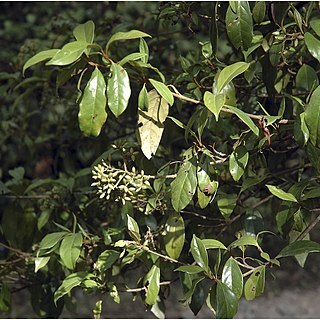Shrubs or small trees, evergreen, to 9 m tall. Bark light brown. Branchlets of current year with dense brown lenticels, initially with lepidote scales, glabrescent; branchlets of previous year gray-brownish, terete, glabrous, with sparse, small, rounded lenticels. Winter buds naked, lanceolate, with lepidote scales. Leaves always opposite, not clustered at apices of branchlets; stipules absent; petiole green, robust, 1-1.5 cm, with lepidote scales; leaf blade green when young, becoming olive-green and lustrous adaxially, oblong-elliptic or oblong-ovate, rarely oblong-obovate, (5-)8-14(-18) × 3.5-5.5(-7.5) cm, leathery, abaxially with lepidote scales, midvein raised abaxially, lateral veins 5-7-jugate, pinnate, arched, rarely branched, anastomosing near margin, raised abaxially, slightly impressed adaxially, veinlets transverse, inconspicuous on both surfaces, not lobed, base broadly cuspidate, without glands, margin entire or sometimes irregularly dentate in upper part, apex acute, sometimes caudate. Flowers appearing after leaves; inflorescence a compound umbel-like cyme, terminal, 7-10 cm in diam.; rays whorled; first node of inflorescence with 4 or 5 rays, lax, with lepidote scales, without large sterile radiant flowers; peduncles absent or very short; bracts persistent, greenish, linear-lanceolate, with sparse lepidote scales; bracteoles scalelike. Flowers on rays of 3rd and 4th orders, not fragrant, shortly pedicellate. Calyx greenish; tube obconical, ca. 1.5 mm, with sparse lepidote scales; lobes broadly ovate, short, glabrous, apex rounded or obtuse. Corolla white, rotate, 6-8 mm in diam., glabrous; tube ca. 4 mm; lobes spreading, broadly ovate, 2-3 mm, apex rounded, margin entire. Stamens subequaling corolla, inserted near base of corolla; filaments 3-4 mm; anthers yellow, broadly elliptic, ca. 1 mm. Styles slightly exceeding calyx lobes; stigmas capitate. Fruit initially turning red, maturing black, broadly ellipsoid, compressed, 8-15(-18) × 6-10 mm, base rounded, apex rounded, glabrous; pyrenes compressed, with 2 dorsal grooves and 3 shallow ventral grooves, both ends rounded. Fl. Mar-Apr, fr. May-Oct. 2n = 18.
More
Shrub or small tree up to 18 m. Young parts densely covered with minute, rusty-coloured, peltate scales, leaving numerous punctiform scars when they fall off. Leaves coriaceous, upper surface glabrous, underside densely covered with minute scales, neither bearded nor glandular-pitted in the nerve-axils, elliptic-lanceolate to lanceolate, 5-13 by 2-4½ cm, apex bluntly acuminate, base attenuate, margins entire; primary nerves 5-7 on each side, rather prominent beneath, anastomosing; petioles 1-1½ cm. Inflorescence umbellate, corymbiform, 5-10 cm across (infructescence up to 15 cm), axes densely squamulate; peduncle very short, 1-3 cm; primary rays 3-5. Bracts and bract-eoles minute, ovate-lanceolate, fimbriate. Flowers fragrant, about 5 mm wide. Calyx-teeth ovate-triangular, obtuse, light-margined, squamulate, about ¾ mm long. Corolla white, glabrous within, squamulate without, globular in bud, nearly rotate (only slightly campanulate) when open, tube 1 mm, lobes broad-ovate, rounded, somewhat overlapping, 2 mm. Stamens somewhat exserted; filaments in bud with inflexed top, inserted near base of corolla, 3-4 mm; anthers elliptic, 1 mm. Ovary cylindric, lepidote, 1½-2 mm long. Drupe elliptic or slightly obovate, much compressed, young squamulose, ripening black, 9-11 (-12) mm by 6-7 mm. Endocarp undulate in cross-section, with 2 dorsal and 3 ventral grooves.

